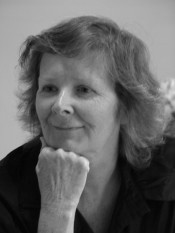THE AUTHOR
I would like to acknowledge with appreciation Patricia Vinnicombe and the contribution her prior research on Queenie made to this book.
 My relationship with Queenie extended back to the early 1990's when I met her in her role as cultural leader of the Warmun Community, while I was working to establish a commercial art gallery for all of the women of the community who were not represented by the art market which seemed to prefer the artwork of the men at the time. The Ochre Gallery became a type of resource center based on a community based agency model, to promote the women's the cultural leadership as well as the art, the old men such as Rover Thomas then also became involved in the gallery.
My relationship with Queenie extended back to the early 1990's when I met her in her role as cultural leader of the Warmun Community, while I was working to establish a commercial art gallery for all of the women of the community who were not represented by the art market which seemed to prefer the artwork of the men at the time. The Ochre Gallery became a type of resource center based on a community based agency model, to promote the women's the cultural leadership as well as the art, the old men such as Rover Thomas then also became involved in the gallery.
The gallery was established in the township of Kununurra to be accessible to the tourism market. How this relationship began was that I had travelled in the Kimberley for some time and returned for my second visit when I was invited to attend an aboriginal arts conference in the Kimberley. My professional background was in community development work, and when I attended the art conference I was shocked at the lack of representation or support of women artists. On that day I attended the conference I made the decision to relocate to the Kimberley to establish an art gallery and resource centre for the local women, although it did not take long for the men to join us also, or for the focus of the Gallery to be on the artwork of women of Warmun Community. As the cultural leader of the community Queenie became my mentor, she was the one I would always seek advice from when establishing the gallery, and when cultural celebrations were going to be held in the gallery she would always direct those activities. Sadly illness (and burn out) forced me to close the gallery several years later, this prompted the establishment of an art gallery at the community which has been an excellent outcome for the Gija women I have developed lasting relationships with, and who I have continued to support in other ways. I was absent from the Kimberley for sometime while I recovered and took time to decide if I would return to the remote Kimberley and if so what was it I would want to do. During that time I sustained my connection with the Gija women, and our relationship has re-invented itself several times during the many years of our relationship.
Today I credit my current ways of working and what I do to those same women, and men, especially Queenie, who taught me so much and seeded within me the inspiration that I have drawn on to develop a cultural mapping methodology. During the research and development of Queenie's book, between 2002 and 2008, two things happened that clarified for me what it was I meant to do. Firstly I undertook my first official cultural mapping project, (although I had documented hundreds of the women's stories for them in the gallery) when one of the Texas Downs elders Patrick Mung and I climbed into a helicopter to fly across the vast cattle station that Queenie had known as her home to identify the many cultural and historical sites that were to be included in the book. Patrick and I did this exercise together so that Patrick (as an elder with authority for that area) could give his permission as to which sites we actually photographed or used in the story.
However before we got into the helicopter I had a most tragic realization as I met with the ‘Texas Mob' so we could discuss who might be best to accompany me in the helicopter. Patrick, as I learnt, was the only remaining elder of his community who could physically go out into his traditional lands and know where to locate the sacred sites! Finding this out was a huge a shock and brought home to me in a very real way what this country was about to lose. Many of the elders had talked of their concern about the loss of their knowledge, as they were finding it harder to engage their youth in listening to their stories, as they had to compete with the impact of westernization, and the many distractions it created.
The next significant thing that happened was that I had gathered a large amount of research about Queenie for the book, some had to be repatriated out of archives or from researchers as it had been gathered years before, from Queenie. Then once I had that large body of multi media research I needed a way to effectively manage it so that I could show it and discuss it with the women in a collated way, this is how I came to develop the cultural mapping software - almost by accident. Now my work is focused around cultural mapping and developing tools for indigenous communities to easily manage their cultural data and to engage their young people in the process. I feel that the old people such as Queenie had been preparing me all along for this work, and it was the book that finally helped me to see what I was meant to do. (thank you Queenie)
JENNIFER JOI FIELD
To contact the Author visit www.culturalmapping.com




